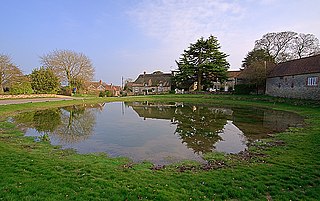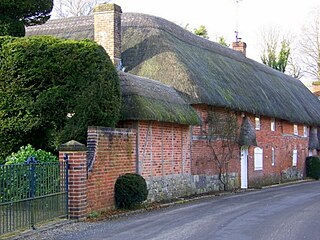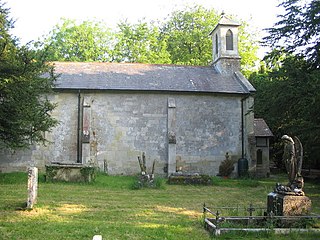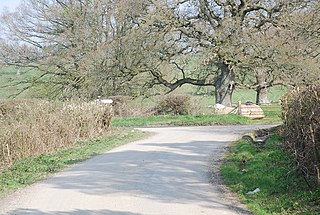Related Research Articles

Wiltshire is a ceremonial county in South West England. It borders Gloucestershire to the north, Oxfordshire to the north-east, Berkshire to the east, Hampshire to the south-east, Dorset to the south, and Somerset to the west. The largest settlement is Swindon, and Trowbridge is the county town.

Malmesbury Abbey, at Malmesbury in Wiltshire, England, is a former Benedictine abbey dedicated to Saint Peter and Saint Paul. It was one of the few English religious houses with a continuous history from the 7th century through to the Dissolution of the Monasteries.

Amesbury is a town and civil parish in Wiltshire, England. It is known for the prehistoric monument of Stonehenge which is within the parish. The town is claimed to be the oldest occupied settlement in Great Britain, having been first settled around 8820 BC. The parish includes the hamlets of Ratfyn and West Amesbury, and part of Boscombe Down military airfield.

Shaftesbury Abbey was an abbey that housed nuns in Shaftesbury, Dorset. It was founded in about 888, and dissolved in 1539 during the English Reformation by the order of Thomas Cromwell, minister to King Henry VIII. At the time it was the second-wealthiest nunnery in England, behind only Syon Abbey.

Cranborne Chase is an area of central southern England, straddling the counties Dorset, Hampshire and Wiltshire. It is part of the Cranborne Chase and West Wiltshire Downs Area of Outstanding Natural Beauty (AONB).

Ansty is a small village and civil parish in southwest Wiltshire, England, about 6 miles (10 km) east of Shaftesbury. The village is just north of the A30, between Shaftesbury and Salisbury. The parish includes the hamlet of Ansty Coombe.

Broad Chalke, sometimes spelled Broadchalke, Broad Chalk or Broadchalk, is a village and civil parish in Wiltshire, England, about 8 miles (13 km) west of the city of Salisbury. The civil parish includes the hamlets of Knapp, Mount Sorrel and Stoke Farthing.

Tisbury is a large village and civil parish approximately 13 miles (21 km) west of Salisbury in the English county of Wiltshire. With a population at the 2011 census of 2,253 it is a centre for communities around the upper River Nadder and Vale of Wardour. The parish includes the hamlets of Upper Chicksgrove and Wardour.

Swallowcliffe is a small village and civil parish in Wiltshire, England, about 2 miles (3.2 km) southeast of Tisbury and 11 miles (18 km) west of Salisbury. The village lies about half a mile north of the A30 Shaftesbury-Wilton road which crosses the parish.

Chisbury is a hamlet and prehistoric hill fort in the civil parish of Little Bedwyn in Wiltshire, England. Chisbury is about 4 miles (6 km) west of Hungerford and about 6 miles (10 km) south-east of Marlborough.

Donhead St Andrew is a village and civil parish in Wiltshire, England, on the River Nadder. It lies 4 miles (6.4 km) east of the Dorset market town of Shaftesbury. The parish includes the hamlets of West End, Milkwell and Brook Waters.
Ælfgifu of Shaftesbury was the first wife of King Edmund I. She was Queen of the English from her marriage in around 939 until her death in 944. Ælfgifu and Edmund were the parents of two future English kings, Eadwig and Edgar. Like her mother Wynflaed, Ælfgifu had a close and special if unknown connection with the royal nunnery of Shaftesbury (Dorset), founded by King Alfred, where she was buried and soon revered as a saint. According to a pre-Conquest tradition from Winchester, her feast day is 18 May.

Chicklade is a small village and civil parish in Wiltshire, South West England. The village is on the A303 road, about 7 miles (11 km) south of Warminster. The parish includes the hamlet of Upper Pertwood.

Castle Ditches is the site of an Iron Age trivallate hillfort in the south-east of Tisbury parish in Wiltshire, England.

Teffont Evias is a small village and former civil parish, now in the parish of Teffont, on the Nadder valley in the south of Wiltshire, England. Edric Holmes described the village as "most delightfully situated", and Maurice Hewlett included Teffont in his list of the half dozen most beautiful villages in England. The present buildings are mostly of local stone, and several are thatched.

Teffont Magna, sometimes called Upper Teffont, is a small village and former civil parish, now in the parish of Teffont, in the Nadder valley in the south of the county of Wiltshire, England. For most of its history, Teffont Magna was a chapelry of neighbouring Dinton. In 1934 it was combined with the parish of Teffont Evias, just to the south, to form a united Teffont parish.

Wardour is a settlement in the civil parish of Tisbury, in Wiltshire, England, about 13 miles (21 km) west of Salisbury and 4 miles (6 km) south of Hindon.

Teffont is a civil parish in the south of Wiltshire, England, consisting of the villages of Teffont Magna and Teffont Evias. It is in the Nadder valley, north of the river, about 10 miles (16 km) west of Salisbury. The parish was created in 1934 by combining the two Teffonts. The population taken at the 2011 census was 248.

Sutton Mandeville is a small village and civil parish in Wiltshire, England, in the Nadder valley and towards the east end of the Vale of Wardour. The village lies south of the river and north of the A30 Shaftesbury-Wilton road, about 7 miles (11 km) west of Wilton and 2.5 miles (4 km) east of the large village of Tisbury.

West Tisbury is a civil parish in southwest Wiltshire, England. The parish takes in the southwestern quarter of the village of Tisbury and extends about 3.8 miles (6.1 km) westward; Tisbury is about 13 miles (21 km) west of Salisbury.
References
- ↑ Pugh, R.B.; Crittall, Elizabeth, eds. (1956). "Victoria County History: Wiltshire: Vol 3 pp150-155 – Religious Houses: Introduction". British History Online. University of London. Retrieved 13 June 2020.
- ↑ Goodchild, Rev W (June 1929). "Tisbury in the Anglo-Saxon Charters". Wiltshire Archaeological and Natural History Magazine. 44: 322–331 – via Internet Archive.
- ↑ Historic England. "Site of Saxon monastery (210467)". Research records (formerly PastScape). Retrieved 13 June 2020.